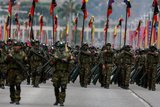Raytheon's AESA radars continue to set standards
Raytheon Company's active electronically scanned array radar technology recently achieved more than 250,000 operational flight hours. Used by customers around the world on multiple platforms, more than 300 radar systems have been delivered to domestic and international customers to help ensure their mission success.
"We believe Raytheon's AESA technology is the cornerstone of future fighter aircraft," said Mark Kula, vice president, Tactical Airborne Systems, for Raytheon Space and Airborne Systems. "No one offers Raytheon's level of operational AESA capability and mission support. Our leading-edge AESA technology is combat-proven, in production, and available today."
Today's changing threat environment drives warfighters' need for technologically advanced sensors that will keep existing platforms relevant and operational at a moment's notice. Raytheon's AESA radars provide a significant advantage in the demanding fighter aircraft environment, ensuring customers remain at the forefront of tactical capabilities to complete their mission.
"Raytheon built the first operational AESA fighter radar more than 10 years ago with the APG-63(V)2 on the F-15C," said Kula. "Since then, we have continually evolved our AESA technology to ensure we can provide incomparable detection, targeting, tracking and self-protection in the competitive and complex mission landscape."
Raytheon's versatile family of AESA radars delivers multirole, multimission support with superior fighter flexibility, improved situational awareness, and optimal performance in all environments. All Raytheon AESA radar models are scalable to be easily tailored to any tactical fighter platform. In addition to enhanced capabilities, this leading-edge AESA technology provides greater reliability and maintainability, which results in lower life-cycle costs.
Source: Raytheon
More from Digital Battlespace
-
![Babcock nears first customer for Nomad AI translation tool]()
Babcock nears first customer for Nomad AI translation tool
Nomad can provide militaries with real-time intelligence, saving critical time on the battlefield.
-
![AUSA 2025: Israel’s Asio Technologies to supply hundreds of improved Taurus tactical systems]()
AUSA 2025: Israel’s Asio Technologies to supply hundreds of improved Taurus tactical systems
Taurus operates alongside the Israel Defense Forces’ Orion system which supports mission management across tens of thousands of manoeuvring forces, from squad leaders to battalion commanders.
-
![AUSA 2025: Kopin pushes micro-LED plans as China moves faster]()
AUSA 2025: Kopin pushes micro-LED plans as China moves faster
The plan for the new displays follows fresh investment in Kopin’s European facilities by Theon and an order for head-up displays in fielded aircraft, with funding from the US Department of Defense.
-
![AUSA 2025: Persistent Systems to complete its largest order by year’s end]()
AUSA 2025: Persistent Systems to complete its largest order by year’s end
Persistent Systems received its largest ever single order for its MPU5 devices and other systems earlier this month and has already delivered the 50 units to the US Army’s 4th Infantry Division.
-
![Aselsan brings in dozens of companies and systems under the Steel Dome umbrella]()
Aselsan brings in dozens of companies and systems under the Steel Dome umbrella
Turkey has joined the family of countries attempting to establish a multilayered air defence system with government approval in August 2024 for the effort landed by Aselsan. Dubbed Steel Dome, the programme joins Israel’s Iron Dome, the US Golden Dome, India’s Mission Sudarshan Chakra and South Korea’s low-altitude missile defence system.
-
![DSEI 2025: MARSS unveils new agnostic multidomain C4 system]()
DSEI 2025: MARSS unveils new agnostic multidomain C4 system
MARSS’ NiDAR system has been deployed using sensors from static platforms to provide detection and protection for static sights, such as critical infrastructure, ports and military bases.



























